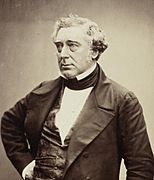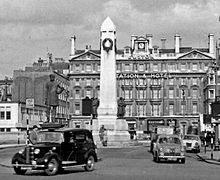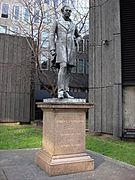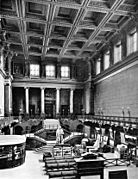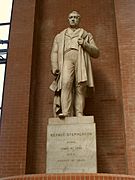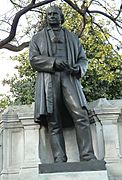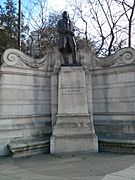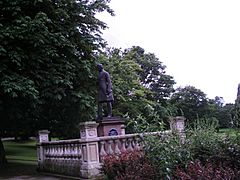Statue of Robert Stephenson facts for kids
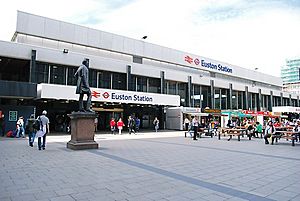
This is a large bronze statue of Robert Stephenson, a famous engineer. It was created by an artist named Carlo Marochetti. You can usually find it outside Euston railway station in London, England. The statue was put there in 1871. It's special because it's one of the few things left from the original station, which was rebuilt in the 1960s. In 1974, it became a Grade II listed building, which means it's an important historical structure. In 2020, the statue was temporarily moved so that Euston station could be updated for the new High Speed 2 (HS2) railway line.
Contents
What the Statue Looks Like
The bronze statue is about 2.7 meters (nearly 9 feet) tall. It shows Robert Stephenson standing in a relaxed way, without a hat. He's dressed in typical Victorian fashion from his time, wearing a long coat and trousers. In his right hand, he holds a document that's partly unrolled. His left hand rests on his hip.
The statue stands on a red granite base. On the base, it says: ROBERT STEPHENSON BORN OCTOBER 16TH 1803 DIED OCTOBER 12TH 1859
How the Statue Was Made
After Robert Stephenson died on October 12, 1859, a group called the Institute of Civil Engineers decided to create a memorial for him. They asked Carlo Marochetti to make the statue. The statue was finished before Marochetti himself died in 1867. However, it stayed in storage for a while because people couldn't agree on where to put it and other statues.
The Institute of Civil Engineers had also asked Marochetti to make statues of two other important engineers:
- Isambard Kingdom Brunel, who died a few weeks before Stephenson in 1859.
- Joseph Locke, who died a year later in 1860.
The original idea was to put all three statues together in a well-known spot in Parliament Square in London. This area was then known as the churchyard of St Margaret's, Westminster. It was near the statue of George Canning and the offices of the Institute of Civil Engineers. However, in 1868, the government office in charge, the Office of Works, decided against it. They wanted to save that space only for statues of politicians.
In the end, the three statues were placed in different locations:
- Marochetti's statue of Joseph Locke was put in Locke Park in Barnsley in 1866. This statue is also a Grade II listed building. A copy of it is in Barentin, France, where Locke designed a railway bridge.
- The statue of Brunel was placed in 1874 on the Victoria Embankment in London. It stands on a Portland stone base with special walls and benches designed by architect Richard Norman Shaw. This statue became a Grade II listed building in 1958.
The Statue at Euston Station
The Institute of Civil Engineers gave the Robert Stephenson statue to the London and North Western Railway company. This company was formed in 1846 by joining several smaller railways, including ones that Robert Stephenson or his father, George Stephenson, had worked for. Euston was the main London station for this railway.
There was already a marble statue of George Stephenson, Robert's father, inside the main hall of Euston station. This statue, made by Edward Hodges Baily in 1852, is now at the National Railway Museum in York. Like Robert's statue, it shows George Stephenson standing in his everyday clothes, holding a partly unrolled document.
The statue of Robert Stephenson was finally put outside Euston railway station in 1871. It was first placed between the entrance buildings of the station. When the station was rebuilt in the 1960s, the statue was moved to the east side. Then, in 2008, it was moved again to the west side of the station's front area because of new building plans.
The statue is one of the few parts of the original Euston station that still exists after the big changes in the 1960s. It was officially recognized as a Grade II listed building in 1974.
In 2020, the statue was moved again. This was to allow more construction work to update Euston station for the new HS2 railway line, which will connect London to Birmingham.
Images for kids
-
Statue of George Stephenson, now at the National Railway Museum, York, pictured in 2008
-
Statue of Brunel, 2004


